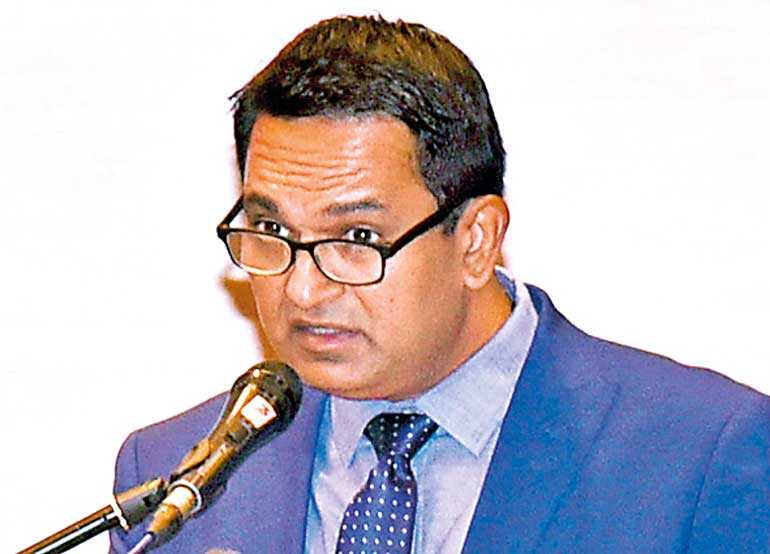Sunday Dec 15, 2024
Sunday Dec 15, 2024
Thursday, 13 February 2020 02:11 - - {{hitsCtrl.values.hits}}

Sri Lanka Apparel Exporters Association Chairman Rehan Lakhany - Pic by Ruwan Walpola
Industry calls for law reforms, e-commerce mechanisms
Hopes Govt. will deliver consistent policies for sector to reach $ 8 b target by 2025
Wants supply bases broadened, offshore management could earn $ 300 m from apparel
Says FTAs started in 2013 should be pursued to boost exports
GSP+ could be utilised more if rules of origin resolved
Feasibility done for Eravur zone, three projects pledged
By Shailendree Wickrama Adittiya
The Sri Lanka apparel industry yesterday called for a number of measures from the Government, including electronic documentation, e-commerce mechanisms, law reforms, and the introduction of a relatively new model of business enhancing offshore activities.
At the Sri Lanka Apparel Export Association’s Annual General Meeting, SLAEA Chairman Rehan Lakhany said the measures were important in boosting the industry, both locally and internationally. He added that the industry has a target of $8 million export turnover in 2025, which is double their present performance.
“Our confidence levels have improved considerably, and hope is there for us that the new administration will ensure a proper delivery of decision-making on policy, and relevant action with time-bound implementation plans,” Lakhany explained, adding that the environment will further improve following the establishment of political stability after Parliamentary Elections this year.
He added that the industry faced a destructive environment in 2019 due to domestic political and global issues, as well as the indecisiveness in decision-making due to “differences between the Legislation and Executive.”
As for industry requests from the Government, Lakhany focused on the need to broaden supply bases both locally and regionally. He said that through offshore management of total supply solutions in collaboration with a regional producer and subcontracting mechanisms, “Sri Lankan exporters will be able to create a new flow of export earnings, which could approximately amount to an additional $ 300 million from our sector alone.”
He requested that this relatively new model of business is encouraged by the Government by revisiting current tax provisions. Lakhany added that the Joint Apparel Association Forum Sri Lanka (JAAF) has already made submissions in this regard.
Lakhany also spoke about B2C transitions, saying that a major issue faced by the industry was the absence of a mechanism to receive payments online. He added that the Government would be required to create a mechanism similar to PayPal for this purpose.
There was also a need for a change of regulations, especially in relation to electronic documentation, and Lakhany called for the Finance Ministry to take responsibility of this.
While saying that there was a need to develop local markets, the SLAEA Chairman said international market penetration was a priority, and commented on Sri Lanka Free Trade Agreements (FTAs), saying they are not providing considerable market access to the industry.
He proposed the continuation of the trade dialogue that commenced in 2013, and added that GSP+, the only available scheme, was not fully utilised.
“Utilisation is only 47%, even though we could have claimed 98% if we could meet the country of origin rules,” he said, bringing up the issue of Sri Lanka depending on other sources for raw material. It is for this reason that the move to establish a textile manufacturing zone in Eravur in Sri Lanka’s Eastern Province is a welcome move.
While the technical feasibility studies have been completed, Lakhany said they expect the Government to develop the infrastructure. “If the completion of the project can be done in one year, we can guarantee a minimum of three projects to be established,” he added.
Focus was also brought to Brexit and the United Kingdom’s decision to leave the European Union (EU), saying that it would be another challenge the industry will have to face following the UK’s transition period.
“We find that trade dialogue shall be directed towards preferential arrangements with EU and UK on a high priority basis, followed by the recommencement of negotiations with China and India,” he said, adding that within the Asian region, Japan was also an important market, hence trade dialogue will essentially be developed.
Touching on how Brexit would affect Sri Lanka in terms of GSP+, British High Commissioner to Sri Lanka Sarah Hulton said the UK was looking forward to new opportunities for both Sri Lanka and the UK, “using bilateral trade as an engine for sustainable growth for the mutual prosperity of both nations.”
She added that the UK was the second largest importer of Sri Lankan goods, and that 30% of all apparel exports to the EU go to the UK. However, she explained that the apparel industry will continue to be a key sector of focus in UK’s trade investments.
“This is an opportunity to reassure you that Sri Lanka will continue to benefit from the same level of access on its exports to the UK that it currently received through GSP+ during our transition period this year,” Hulton said.
She added that all countries that are currently beneficiaries will continue to be beneficiaries to the EU GSP scheme and will continue to enjoy these preferential tariffs through a UK trade preferential scheme.
“The UK government has now launched a four-week consultation on a new UK most favoured nation tariff schedule, which will enter into polls on 1 January, 2021,” she added.
